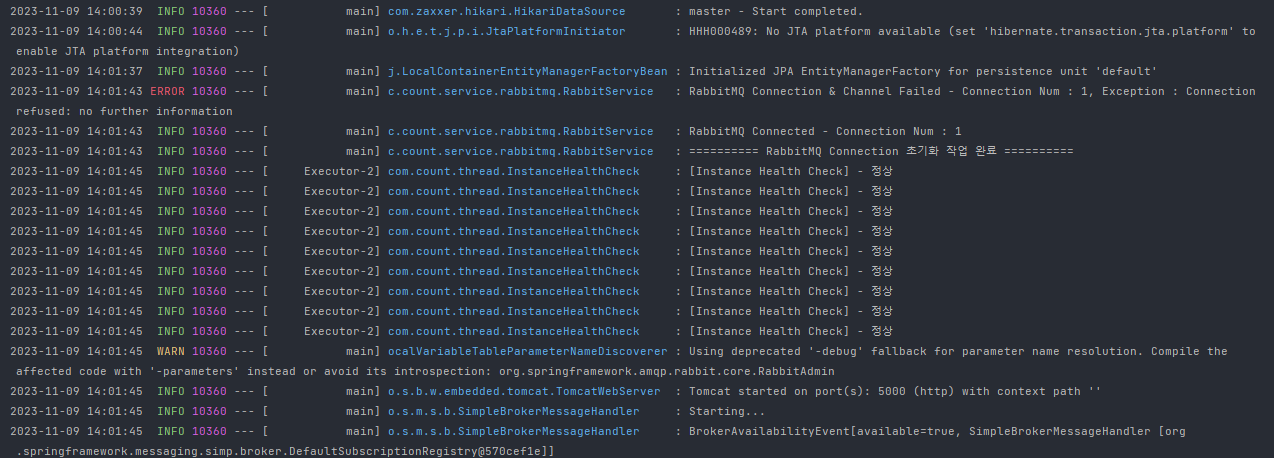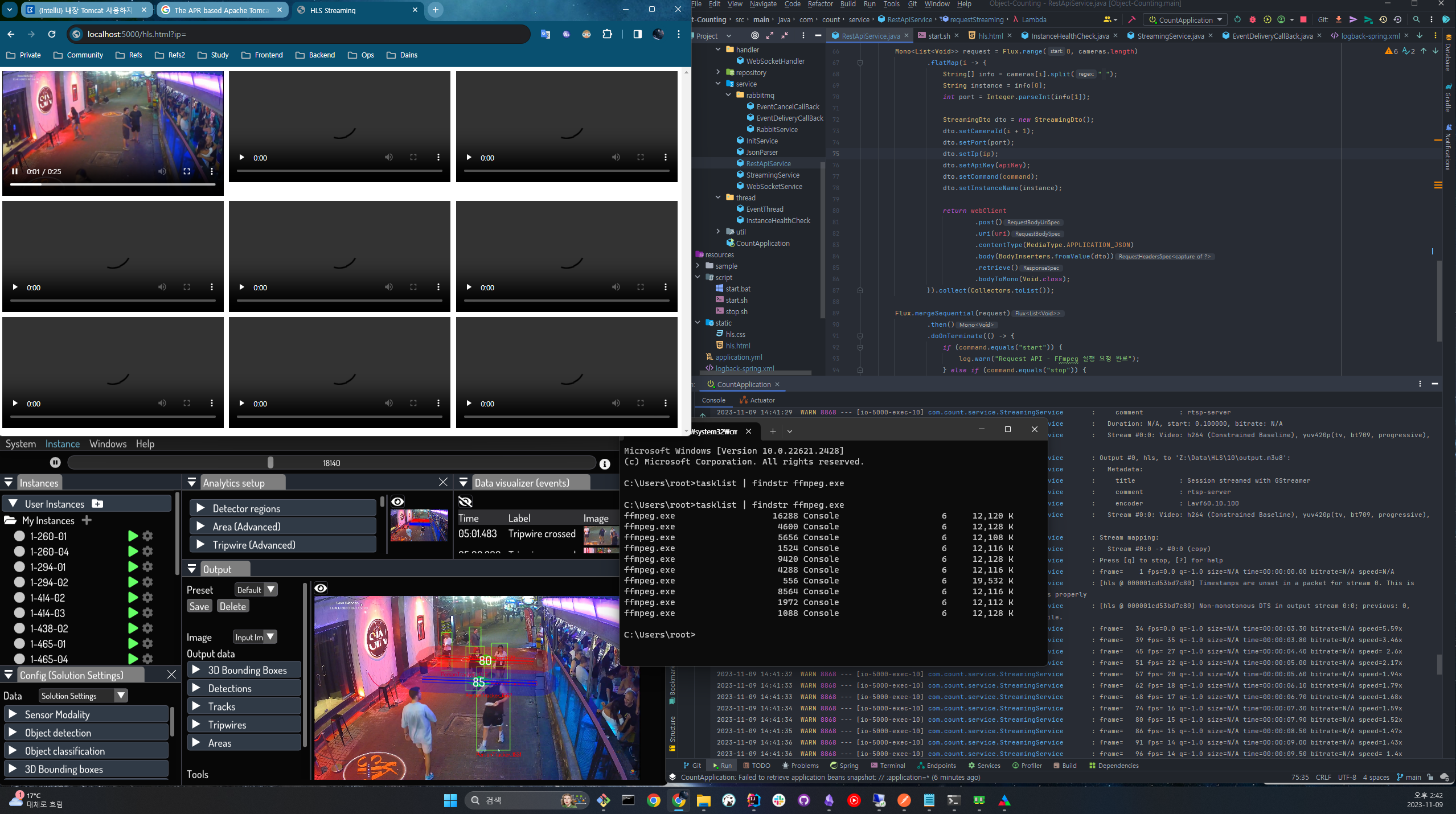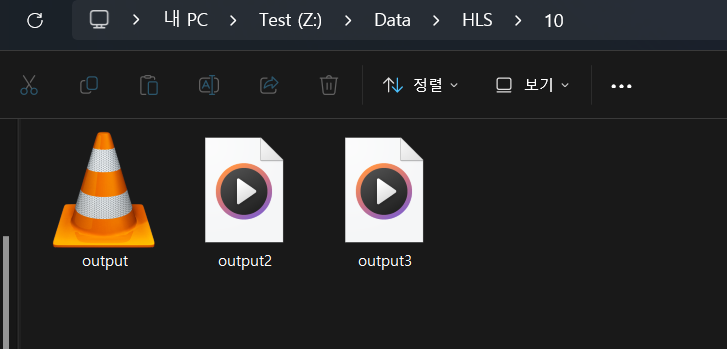📘 RTSP to HLS
OS환경은 Windows 기준으로 개발 하였습니다.
브라우저에서 지원이 안되는 RTSP를 FFmpeg을 이용해 HLS로 변환하여 브라우저에서 실시간 영상을 스트리밍 합니다.
😯 Windows FFmpeg Link
https://ffmpeg.org/download.html
😯 설치 후 시스템 환경변수 설정
setx PATH "%PATH%;{ffpmeg 경로}"
📘 EC2 Setting
😯 RPM 기반 FFmpeg & Java 17 설치
#!/bin/bash
# FFmpeg 설치
cd /usr/local/bin
mkdir ffmpeg
cd ffmpeg
wget https://www.johnvansickle.com/ffmpeg/old-releases/ffmpeg-4.2.1-amd64-static.tar.xz
tar xvf ffmpeg-4.2.1-amd64-static.tar.xz
mv ffmpeg-4.2.1-amd64-static/ffmpeg .
ln -s /usr/local/bin/ffmpeg/ffmpeg /usr/bin/ffmpeg
# Java 17 설치
yum install -y java-17-amazon-corretto-headless
😯 Debian 기반 FFmpeg 설치
apt -y install ffmpeg📘 Config
Task Executor 와 Resource Handler / Cors / WebClient 설정을 해줍니다.
📌 AppConfig
- 어플리케이션에서 사용할 스레드 수를 짐작해서 설정해 줍니다.
@EnableAsync
@Configuration
public class AppConfig {
@Value("${task.executor.core.pool.size}")
private int corePoolSize;
@Value("${task.executor.max.pool.size}")
private int maxPoolSize;
@Value("${task.executor.queue.capacity}")
private int queueCapacity;
// Thread Pool 설정
@Bean
public TaskExecutor executor() {
ThreadPoolTaskExecutor executor = new ThreadPoolTaskExecutor();
executor.setCorePoolSize(corePoolSize);
executor.setMaxPoolSize(maxPoolSize);
executor.setQueueCapacity(queueCapacity);
executor.setThreadNamePrefix("Executor-");
executor.initialize();
return executor;
}
@Bean
public WebClient webClient() {
return WebClient.builder().build();
}
}
📌CorsConfig
- Resource Handler / Cors Mapping을 해줍니다. (설명 생략)
@Configuration
public class CorsConfig implements WebMvcConfigurer {
@Value("${hls.file.path}")
private String hlsFilePath;
// "file:/home/user/videos/" 디렉토리의 리소스를 "/videos/**" 경로로 서비스
@Override
public void addResourceHandlers(ResourceHandlerRegistry registry) {
registry.addResourceHandler("/videos/**")
.addResourceLocations("file:"+hlsFilePath);
}
@Override
public void addCorsMappings(CorsRegistry registry) {
registry.addMapping("/**") // 모든 경로에 대해
.allowedOrigins("*") // 허용할 원본
.allowedMethods("GET", "POST", "PUT", "DELETE") // 허용할 HTTP 메서드
.allowedHeaders("Header1", "Header2", "Header3")
.exposedHeaders("Header1", "Header2")
//.allowCredentials(true)
.maxAge(3600); // 1시간 동안 pre-flight 응답을 캐시
}
}📘 DTO
📌 Streaming DTO
RTSP를 FFmpeg 명령으로 변환하기 위한 정보를 받는 DTO입니다.
@Getter
public class StreamingDto {
@NotNull
private Integer cameraId; // DB에 저장된 CameraID
@NotNull
private String instanceName; // RTSP Topic
@NotNull
private String ip;
@NotNull
private Integer port;
@NotNull
private String command; // start & stop
@NotNull
private String apiKey; // API 호출을 위한 키
}
📌 Instance DTO
인스턴스를 주기적으로 헬스체크하는 Thread에서 Rest API 요청을 위해 필요한 인스턴스 정보입니다.
@Data
@JsonInclude(JsonInclude.Include.NON_NULL)
public class InstanceDto {
@JsonProperty("instance_name")
private String instanceName;
@JsonProperty("solution")
private String solution;
@JsonProperty("solution_name")
private String solutionName;
@JsonProperty("solution_path")
private String solutionPath;
@JsonProperty("solution_version")
private String solutionVersion;
@JsonProperty("state")
private int state;
}📘 Controller
- startConvert() : IP와 Command(start/stop)을 URI Parameter로 보내면
- control() : Control API에 StreamingDTO의 형식대로 API 요청을 하면 FFmpeg 변환 프로세스를 시작합니다.
@Slf4j
@RestController
@RequestMapping("/api/hls")
@RequiredArgsConstructor
public class StreamingController {
private final RestApiService restApiService;
private final StreamingService streamingService;
@Value("${api.key}")
private String apiKey;
@GetMapping("/request")
public void startConvert(@RequestParam String ip, @RequestParam String command) {
restApiService.requestStreaming(ip, command);
}
@PostMapping("/control")
public String controlHls(@Valid @RequestBody StreamingDto request) {
String ok = "{\"code\": 0, \"msg\": \"Success\"}";
String nok = "{\"code\": -1, \"msg\": \"Failure\"}";
try {
if (!StringUtils.hasText(request.getApiKey()) || !apiKey.trim().equals(request.getApiKey().trim())) {
log.error("API Key가 잘못 되었습니다. - {}", request);
return nok;
}
// Command가 Start or Stop 일때 FFmpeg 프로세스 실행 / 중지
if (request.getCommand().equalsIgnoreCase("start")) {
streamingService.startConverter(request.getCameraId(), request.getInstanceName(), request.getIp(), request.getPort());
} else if (request.getCommand().equalsIgnoreCase("stop")) {
streamingService.stopHlsConverter(request.getCameraId(), request.getInstanceName());
}
} catch (Exception e) {
log.error("HLS Controller Exception - {}, {}", e.getMessage(), request.toString());
e.printStackTrace();
return nok;
}
return ok;
}
}📘 Service
📌 Rest API Service
- getInstance() : 인스턴스 헬스체크를 위해 인스턴스에 GET 요청을 보내기 위한 함수입니다.
- portInstance() : 헬스체크 로직 내에서 인스턴스가 Running 중이 아니라면 실행시키는 API 요청 함수입니다.
- requestStreaming() : FFmpeg을 이용하여 RTSP를 HLS로 변환 명령을 실행시키는 함수입니다.
@Slf4j
@Service
@RequiredArgsConstructor
public class RestApiService {
private final WebClient webClient;
@Value("${api.key}")
private String apiKey;
private String uri = "http://localhost:5000/api/hls/control";
public Mono<String> getInstance(final String uri) throws Exception{
return webClient.get()
.uri(uri)
.retrieve()
.bodyToMono(String.class);
}
/**
* POST 요청(URI 는 / 부터 시작해야 함)
* @param uri
* @param data
* @return
*/
public Mono<String> postInstance(final String uri, final Object data) throws Exception{
return webClient.post()
.uri(uri)
.bodyValue(data)
.retrieve()
.bodyToMono(String.class);
}
public void requestStreaming(String ip, String command) {
String[] cameras = {
"1-260-01 8554",
"1-260-04 8555",
"1-294-01 8556",
"1-294-02 8557",
"1-414-02 8558",
"1-414-03 8559",
"1-438-02 8560",
"1-465-01 8561",
"1-465-04 8562"
};
Mono<List<Void>> request = Flux.range(0, cameras.length)
.flatMap(i -> {
String[] info = cameras[i].split(" ");
String instance = info[0];
int port = Integer.parseInt(info[1]);
StreamingDto dto = new StreamingDto();
dto.setCameraId(i + 1);
dto.setPort(port);
dto.setIp(ip);
dto.setApiKey(apiKey);
dto.setCommand(command);
dto.setInstanceName(instance);
return webClient
.post()
.uri(uri)
.contentType(MediaType.APPLICATION_JSON)
.body(BodyInserters.fromValue(dto))
.retrieve()
.bodyToMono(Void.class);
}).collect(Collectors.toList());
Flux.mergeSequential(request)
.then()
.doOnTerminate(() -> {
if (command.equals("start")) {
log.warn("Request API - FFmpeg 실행 요청 완료");
} else if (command.equals("stop")) {
log.warn("Request API - FFmpeg 중지 요청 완료");
}
})
.subscribe();
}
}
📌 StreamingService
컨트롤러로 부터 DTO를 받아 RTSP Topic, InstanceName 등 정보를 이용해 FFmpeg 프로세스를 실행합니다.
여기서 다양한 옵션을 통해 FFmpeg 프로세스의 Low Latency를 위한 튜닝 작업을 합니다.
@Slf4j
@Service
public class StreamingService {
@Value("${ffmpeg.option.hls.time}")
private int hlsTime;
@Value("${ffmpeg.option.hls.list.size}")
private int hlsListSize;
@Value("${ffmpeg.option.hls.flags}")
private String hlsFlags;
@Value("${ffmpeg.option.start.number}")
private String startNumber;
@Value("${hls.file.path}")
private String hlsFilePath;
private Map<Integer, Process> processMap = new ConcurrentHashMap();
private String scriptPath = "script/";
/**
* FFmpeg 프로세스 시작
* @param cameraId
* @param instanceName
* @param ip
* @param port
* @throws IOException
* @author 신건우
*/
public void startConverter(final Integer cameraId, final String instanceName, final String ip, final Integer port) throws IOException {
Process process = processMap.get(cameraId);
// FFmpeg에 사용할 명령어를 String Builder를 이용해 작성 합니다.
if (process == null || !process.isAlive()) {
StringBuilder builder = new StringBuilder();
builder.append("ffmpeg -i rtsp://");
builder.append(ip);
builder.append(":");
builder.append(port);
builder.append("/");
builder.append(instanceName);
builder.append(" -c:v copy -c:a copy ");
// builder.append(" -profile:v baseline ");
// builder.append(" -fflags nobuffer ");
// builder.append(" -tune zerolatency ");
builder.append(" -hls_time ").append(hlsTime);
builder.append(" -hls_list_size ").append(hlsListSize);
builder.append(" -hls_flags ").append(hlsFlags);
builder.append(" -start_number ").append(startNumber);
builder.append(" ").append(hlsFilePath).append(cameraId).append(File.separator).append("output.m3u8");
// 프로세스를 시작하게 할 명령어 입니다.
String cmd = builder.toString();
File file = new File(hlsFilePath + cameraId);
// 파일이 없으면 생성합니다.
if (!file.exists()) file.mkdirs();
// 명령을 전달하여 프로세스 실행합니다.
process = Runtime.getRuntime().exec(cmd);
// 프로세스 출력 에러 스트림 리다이렉션
BufferedReader errorStream = new BufferedReader(new InputStreamReader(process.getErrorStream()));
String line;
AtomicInteger exitCode = new AtomicInteger();
while ((line = errorStream.readLine()) != null) {
log.warn(line);
}
Process finalProcess = process;
CompletableFuture.runAsync(() -> {
try {
exitCode.set(finalProcess.waitFor());
log.warn("FFmpeg process exited with exit code: {}", exitCode);
} catch (InterruptedException e) {
log.error("Process Wait For Failed - {}", e.getMessage());
}
});
// 카메라의 식별자와 프로세스를 Map에 넣습니다.
processMap.put(cameraId, process);
log.warn("FFmpeg 변환 프로세스가 시작됩니다. - {}, {}, {}, {}, {}, {}", cameraId, instanceName, ip, port, cmd, process.isAlive());
log.error("Process Map 테스트 : {}", processMap.entrySet().stream().toList().toString());
} else {
log.warn("FFmpeg 변환 프로세스가 이미 실행 중 입니다.");
}
}
/**
* FFmpeg 프로세스 종료
* @param cameraId
* @param instanceName
* @throws IOException
* @author 신건우
*/
public void stopHlsConverter(final Integer cameraId, final String instanceName) throws IOException {
// Process process = processMap.get(cameraId);
// 프로세스가 존재하면 종료합니다.
// if (process != null && process.isAlive()) {
// process.destroy();
//
// try {
// process.waitFor();
// } catch (Exception e) {
// log.error("Process Wait For Failed - {}", e.getMessage());
// }
// process = null;
Runtime.getRuntime().exec("taskkill /IM ffmpeg.exe /F /T");
File file = new File(hlsFilePath + cameraId);
// 파일이 존재하면 제거합니다.
if (file.exists()) {
file.delete();
}
// Map에서 프로세스를 제거합니다.
// processMap.remove(cameraId);
// } else {
// log.warn("FFmpeg 변환 프로세스가 실행 중이 아닙니다.");
// }
}
/**
* FFmpeg 프로세스 Health Check
*/
@Scheduled(fixedDelayString = "${ffmpeg.check.interval.millis}")
public void checkProcess() {
if (processMap.isEmpty()) {
log.warn("Check FFmpeg - 카메라 변환 프로세스가 실행 중이 아닙니다.");
}
processMap.forEach((cameraId, process) -> {
if (process != null) {
if (process.isAlive()) {
log.warn("Check FFmpeg - {}번 카메라 변환 프로세스가 실행 중 입니다.", cameraId);
}
}
});
}
}📘 Health Check Thread
카메라 인스턴스의 상태를 1분마다 체크 (Thread.sleep) 하여 상태가 4(Running)이 아니면 다시 실행시키는 백그라운드 데몬 스레드 입니다.
@Slf4j
@Service
@RequiredArgsConstructor
public class InstanceHealthCheck extends Thread {
private final RestApiService restApiService;
private final TaskExecutor executor;
private final ObjectMapper mapper;
// private String[] instanceName = {"1-260-01", "1-260-04", "1-294-01", "1-294-02", "1-414-02", "1-414-03", "1-438-02", "1-465-01", "1-465-04"};
private String[] instanceName = {"Tripwire-Test"};
private String server = "http://localhost:8080/";
@PostConstruct
public void init() {
this.InstanceConnection();
}
@Override
public void run() {
while (true) {
Arrays.stream(instanceName).forEach(name -> {
try {
String uri = server + "api/instance/get?instance_name=" + name;
String result = restApiService.getInstance(uri).block();
InstanceDto[] instanceDtoArray = mapper.readValue(result, InstanceDto[].class);
if (instanceDtoArray != null && instanceDtoArray.length > 0) {
Arrays.stream(instanceDtoArray).forEach(instance -> {
if (instance.getState() == 4) {
return;
}
if (instance.getState() == 0 || instance.getState() == 1 || instance.getState() == 3 || instance.getState() == 5) {
String startUri = server + "api/instance/start";
InstanceDto reqBody = new InstanceDto();
reqBody.setInstanceName(instance.getInstanceName());
reqBody.setSolution(instance.getSolution());
try {
String requestBody = mapper.writeValueAsString(reqBody);
restApiService.postInstance(startUri, requestBody).block();
log.info("[{}] Instance Start", reqBody.getInstanceName());
} catch (Exception e) {
log.error("{} Instance Start with An Exception : {}, {}",reqBody.getInstanceName(), e.getMessage(), e.getCause());
}
}
});
}
log.info("[Instance Health Check] - 정상");
} catch (Exception e) {
log.warn("Instance 서버가 오프라인 입니다.");
}
});
try {
Thread.sleep(60000);
} catch (InterruptedException e) {
e.printStackTrace();
}
}
}
private void InstanceConnection() {
executor.execute(() -> {
InstanceHealthCheck thread = new InstanceHealthCheck(restApiService, executor, mapper);
thread.setDaemon(true);
executor.execute(thread);
});
}
}
📘 View
Library : hls.js
단순히 비디오 9개를 붙여서 HLS를 실행하는 코드라서 설명은 생략합니다.
<!DOCTYPE html>
<html lang="en">
<head>
<meta charset="UTF-8">
<meta name="viewport" content="width=device-width, initial-scale=1.0">
<title>HLS Streaming</title>
<!-- hls.js 라이브러리 추가 -->
<script src="https://cdn.jsdelivr.net/npm/hls.js@latest"></script>
<link rel="stylesheet" type="text/css" href="hls.css">
</head>
<body>
<div class="video-container">
<video id="video1" width="640" height="360" controls></video>
<video id="video2" width="640" height="360" controls></video>
<video id="video3" width="640" height="360" controls></video>
<video id="video4" width="640" height="360" controls></video>
<video id="video5" width="640" height="360" controls></video>
<video id="video6" width="640" height="360" controls></video>
<video id="video7" width="640" height="360" controls></video>
<video id="video8" width="640" height="360" controls></video>
<video id="video9" width="640" height="360" controls></video>
</div>
<script>
// 함수로 스트리밍 로직 분리
function startStreaming(videoElement, videoSource) {
if (Hls.isSupported()) {
var hls = new Hls();
hls.loadSource(videoSource);
hls.attachMedia(videoElement);
hls.on(Hls.Events.MANIFEST_PARSED, function () {
videoElement.play();
});
}
// 브라우저가 기본적으로 HLS를 지원하는 경우
else if (videoElement.canPlayType('application/vnd.apple.mpegurl')) {
videoElement.src = videoSource;
videoElement.addEventListener('loadedmetadata', function () {
videoElement.play();
});
}
}
document.addEventListener('DOMContentLoaded', function () {
// 비디오 요소와 소스 배열
var videos = [
{ element: document.getElementById('video1'), source: 'http://127.0.0.1:5000/videos/1/output.m3u8' },
{ element: document.getElementById('video2'), source: 'http://127.0.0.1:5000/videos/2/output.m3u8' },
{ element: document.getElementById('video3'), source: 'http://127.0.0.1:5000/videos/3/output.m3u8' },
{ element: document.getElementById('video4'), source: 'http://127.0.0.1:5000/videos/4/output.m3u8' },
{ element: document.getElementById('video5'), source: 'http://127.0.0.1:5000/videos/5/output.m3u8' },
{ element: document.getElementById('video6'), source: 'http://127.0.0.1:5000/videos/6/output.m3u8' },
{ element: document.getElementById('video7'), source: 'http://127.0.0.1:5000/videos/7/output.m3u8' },
{ element: document.getElementById('video8'), source: 'http://127.0.0.1:5000/videos/8/output.m3u8' },
{ element: document.getElementById('video9'), source: 'http://127.0.0.1:5000/videos/9/output.m3u8' },
];
// 각 비디오를 스트리밍 시작
videos.forEach(function (videoInfo) {
startStreaming(videoInfo.element, videoInfo.source);
});
document.addEventListener('keydown', function(event) {
if (event.key === 'Enter') {
videos.forEach(function (videoInfo) {
videoInfo.element.play();
})
}
})
});
</script>
</body>
</html>.video-container {
display: grid;
grid-template-columns: repeat(3, 1fr);
gap: 10px; /* 각 비디오 사이의 간격 조정 가능 */}
.video-container video {
width: 100%;
height: auto;
}📘 실행
Controller의 request API를 이용해 FFmpeg을 실행해 RTSP를 변환해서 브라우저에 HLS를 재생합니다.
노트북의 GPU 사양이 안좋기 때문에 1개의 비디오만 돌려보겠습니다.
Request URI : http://localhost:5000/api/hls/request?ip={ip}&command=start
FFmpeg을 실행하는 로직은 프로세스의 응답을 WaitFor 하기 때문에 백그라운드(&)로 API를 요청 해줍니다.
Bash -> curl -X GET http://localhost:5000/api/hls/request?ip={ip}&command=start &

실행 후, 프로세스를 확인 해보면 9개의 FFmpeg 변환 프로세스가 떠있습니다.
지금은 테스트로 1개의 비디오만 연결했기 때문에 실제론 1개만 변환중이고,
브라우저에서 재생을 시키면 잘 변환되어 스트리밍 됩니다.
세그먼트 파일(.ts)과 재생리스트 파일(.m3u8) 파일도 잘 생기는걸 볼 수 있습니다.

'📘 Backend > Streaming' 카테고리의 다른 글
| GStreamer Pipeline (0) | 2024.02.17 |
|---|
